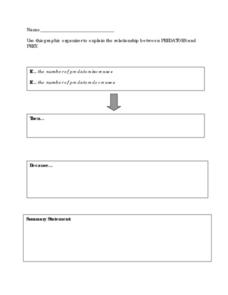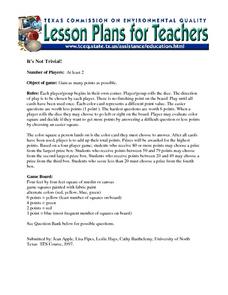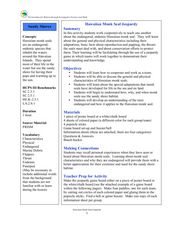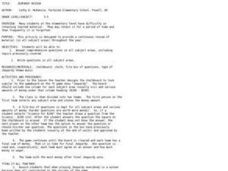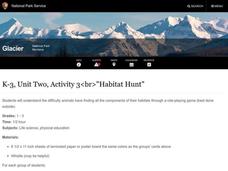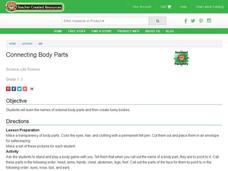Curated OER
Disasters (Natural & Man-made)
Students chose a natural or man-made disaster, such as a tornado or an oil spill, to research using the assigned web sites. They choose a presentation type from a list which includes poetry, radio broadcasts, and safety brochures, to...
Curated OER
Explore the Arctic: A Scavenger Hunt Game
Learners identify major concepts related to the Arctic region and take scientific information and convert it into a usable form. They then gather data from a variety of resources and create an Arctic Scavenger Hunt Game.
Curated OER
Light Travels As A Game
Students identify ways that light can travel and why. In groups, they develop an experiment to show that light can travel because it is a form of energy. They use this information and apply it to other forms of energy to end the lesson.
Curated OER
Predators and Prey
Students explain how the food chain works. They contrast predators with prey and describe their function in nature. Students discuss how the food chain aids in keeping nature balanced. In small groups, they play a game that simulates the...
Curated OER
Tic-Tac-Toe, What Do You Know?
Students review learned material with a game of tic-tac-toe. Students are divided into two groups, x's and o's. Teams are posed a review question and when answered correctly, they place their mark on a tic-tac-toe grid on the board. This...
Curated OER
It's Not Trivial!
Students participate in a trivia game about the environment. They focus on recycling and how to protect the environment. The team with the most correct answers wins.
Curated OER
Jeopardy Review
Young scholars participate in a "Jeopardy" review game. For this review lesson, students are divided into two teams and are asked to pick a question for a specific amount of play money. The game board can be drawn on a chalkboard with a...
Curated OER
Hawaiian Monk Seal Jeopardy
Students explore the Hawaiian monk seal. For this science lesson, students read about the monk seal and participate in a game in which they answer questions about the Hawaiian monk seal.
Curated OER
Jeopardy Review
Students engage in test review. In this test review lesson, students participate in a Jeopardy game. Students work in small groups answering comprehension questions. Standard Jeopardy rules apply.
Curated OER
Animal Camouflage 1
Second graders work in groups and they are asked to line up on either side of the board. They are explained that on the teachers instruction, one student at a time runs to the marked area and brings back the first worm they see. Students...
Curated OER
Human Skeletal System
Students trace the outline of one of their members and draw in the bones from the diagram. They make flashcards of the bones out of index cards. Once the drawings and flashcards are finished, they quiz each other in preparation for a game.
Curated OER
Habitat Hunt
Students discover how hard it is for animals to find all the items needed in their habitat. In this habitat lesson, students play a game in which they pretend to be an animal, they discover that not all animals can find the food needed...
Curated OER
Measuring Elapsed Time
Fifth graders convert units within the same measurement system and be able to determine elapsed time. They are given a start time and an end time of a game. Students determine the amount of elapsed time from the data that is given.
Curated OER
Harbor Estuary
Young scholars study waste and how to eliminate the use of fertilizers. In this estuary lesson students play a pictionary game that helps them to develop a better understanding of an estuary and its issues.
Curated OER
Animal Relationships
Students study energy pyramids, food chains and food webs. In this animal relationships lesson students complete several activities and play a game.
Curated OER
Predator/Prey
Learners explain how the food chain works. They contrast predators with prey and describe their function in nature. Students discuss how the food chain aids in keeping nature balanced. They play a game that simulates the food chain.
Curated OER
Ancient Greece Predicting Outcomes
Sixth graders explore world history by utilizing a SMART board. In this Greek history lesson, 6th graders read different Ancient Greece scenarios and match them with a selection from a list of probable outcomes. Students identify Mt....
Curated OER
Neural Pictionary
High schoolers explore the nervous system. They pictorially illustrate terms that deal with the nervous system. Students play a "pictionary" game to review nervous system vocabulary words.
Curated OER
redator and Prey- Food chain relationships
Pupils s identify the different trophic levels in the food chain and understand the importance of the energy cycle. They create a class food web using index cards and yarn and play a predator/prey game.
Curated OER
Food Webs
Students create a bulletin board display illustrating food chains they make from a list of ocean organisms. Students also play a game showing what happens when one of the organisms is removed from the food chain and how they are all...
Curated OER
Environment: Fishing and Property Rights
Learners participate in a role-playing "fishing game" to discover how over-harvesting can eliminate a resource. In the second round of the game, students are told they can only fish in their assigned territories.
Learners explain the...
Curated OER
Chemical and Physical Changes
Middle schoolers experiment, identify and apply the concepts of chemical and physical changes utilizing real-world examples. They discuss and model physical and chemical changes, answer guided questions and play a game that reinforces...
Curated OER
Hula Hoop Habitats
Young scholars explore migration. In this science lesson, students play a game in which they explore bird migration. Young scholars discuss the needs of birds and play a game in which they "migrate" in order to meet their needs.
Curated OER
Connecting Body Parts
Learners identify body parts. In this human body lesson, students play a game in which they point to body parts called out by the teacher. Learners draw, label, and assemble body parts made from construction paper. Students create...



